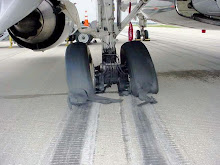One of the first Jewish pilots in World War II will never forget his fall from the sky.
Donna C. Gregory
Richmond.com
Tuesday, November 06, 2001
For 81-year-old George Goldstein, the story begins in 1941 as a 22-year-old Virginia Tech student, planning to become a veterinarian.
Goldstein was in his sophomore year when he received word he was needed for the war effort. After completing pilot training, Goldstein was assigned to the 62nd Flight Squadron, stationed in Newark, N.Y. He piloted P-36s, P-38s and P-40s, and was one of the first to fly the P-47 Thunderbolt in combat.
In January 1943, Goldstein sailed across the Atlantic on the Queen Elizabeth to begin his tour. His destination was a mystery until the squadron was in the midst of the ocean. All he had been told was that he wouldn’t need his summer clothing. Six days later, the Queen Elizabeth landed in Scotland. Goldstein then headed to England.
“When we first got there, we were on an old RAF base. They’d call us in for tea at two o’clock,” Goldstein recalls with a grin, raising thick salt-and-pepper eyebrows. “Even though there was a war on, it was a very leisurely pace.”
Goldstein was one of the first Jewish pilots to fly fighters over Europe. He would fly 69 missions over the next eight months. Mostly, these involved escorting bombers while they pummeled the Germans below. His squadron boasted an eight-to-one victory ratio over German fighters.
But Goldstein’s life took a sharp turn on Dec. 5, 1943. He was preparing for a three-day leave when he was asked to take the place of a fellow pilot who had imbibed too much alcohol at a party the night before.
Goldstein’s plane was old and battle-worn, but he had been assured it would make it safely through one more mission. His commander tempted him with the promise of a five-day leave at the end of the mission. He accepted.
But not long before Goldstein reached his target, his plane’s propeller began surging. He hesitated to turn back toward England, knowing his commander would question his decision to return to base. “I decided too late to go back,” Goldstein says.
The plane’s system failed, leaving Goldstein with no other option than to bail out some 100 miles north of Paris. He disconnected his oxygen tube, but forgot to remove his radio wires. When he ejected into the sky, he came out upside down, and his shin was cut to the bone. “You get a funny feeling when you’re in the clouds,” he says. “It’s like you aren’t even moving, like you’re just hanging there.”
Goldstein descended into an open field and landed on a cow. It broke his fall, but nearly broke his back in the process.
“The cow didn’t seem to mind at all,” Goldstein smiles. “She made a little noise and trotted on off away from me.”
French peasants saw his clumsy landing and urged him to run. He headed across the field and buried himself in a haystack, overlooking a small village. Villagers gave him food and shelter, and tended to his leg. After secretly stowing away at several homes, Goldstein was taken to the town of Amiens where he first met Madame Vignon, a salty 60-year old who carried a gun under her white apron and was in charge of the northern France underground resistance movement. The Germans had killed Madame Vignon’s husband, and she vowed the Germans would not take her without a fight.
With the help of the resistance, Goldstein traveled safely to Paris. He hid out in a secret room at the home of two women for two weeks while he waited for the arrival of a guide from Spain to take him back to England. While there, the women unwisely introduced him to several of their acquaintances. Goldstein believes it was one of the women’s neighbors who alerted the Germans of his presence in Paris.
The day before he was to meet his guide, the German Gestapo took him captive. Armed with submachine guns, the Gestapo surrounded Goldstein and led him to a Mercedes parked on the street. Goldstein and the six women were taken to a Paris jail. Then he was transported to Fresne Prison. There, Goldstein’s leg became terribly infected within the confines of his cold basement cell.
For 10 days, he subsisted on coffee and soup served in greasy steel bowls. The Gestapo interrogated Goldstein, but did not believe his story of being a Jewish pilot from the United States. The interrogations became ugly as the Gestapo tried to pressure Goldstein to tell them that he was an American spy.
Goldstein spent his remaining days as a prisoner of war at a camp in Barth, Germany. Five months later, the Germans were losing their hold in Europe and were near defeat. Goldstein awoke on the morning of May 5, 1945, and immediately noticed the German guards had vanished. After receiving word that the Russians were coming to liberate the camp, the Germans had fled in fear.
Goldstein was promptly sent back to England, then sailed on the Queen Elizabeth back to the United States.
“When we came into the New York harbor and saw the Statue of Liberty, it was the best sight I’d ever seen,”
